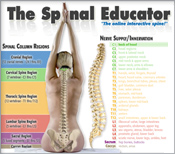| Degeneration and the Chiropractic Lifestyle What is Subluxation Degeneration? Subluxation degeneration is how the body responds to improperly functioning spinal joints. With early detection, appropriate chiropractic care has been shown to slow, stop, or even reverse the early stages of this process. Ask your doctor to design a program of preventive care for you. Normal Cervical Spine Normal curves and proper disc spacing allow normal function of the spine and nervous system. “Normal” 75 Year Old Cervical Spine This 75-year-old patient helps prevent Subluxation Degeneration with many years of regular chiropractic checkups. Like the mineral deposits in a cave, if given enough time adjacent spinal bones can fuse together. Phase One Cervical Spine Loss of normal curves and nervous system dysfunction result from uncorrected spinal trauma. Phase Two Cervical Spine Bone spurs and abnormal bony growths distort the shape and function of the vertebrae. Phase Three Cervical Spine After years of neglect, the improperly functioning spinal joints often fuse together. Motion is the key to joint flexibility. Regular chiropractic care promotes proper joint function and mobility. Usually seen as the misalignment and malfunction of the spine. Normal spinal motion, curves, and disc spacing are altered. Because the body is so adaptable, this early phase can exist without the warning of pain or other symptoms. If left uncorrected, the degeneration continues. Recognized on X-ray views of the spine by visible bone spurs and rough edges of the vertebrae. Soft tissues, such as discs and ligaments degenerate from the lack of normal joint movement. Again, pain or other symptoms may not be present. A lifetime of neglect may cause the eventual fusion of the malfunctioning joints. Atrophy, permanent nerve damage, and soft tissue degeneration are prevalent. Reduced mobility and impaired nervous system function can diminish one's quality of life. Subluxation Degeneration is a process. Regardless of age, when spinal damage goes uncorrected, the body deposits calcium on the surface of adjacent bones that aren’t moving properly. If neglected long enough, this splinting effect can result in complete fusion. This worsening process is called Subluxation Degeneration and can occur throughout the spine. Researchers recognize several phases of spinal decay. THE CHIROPRACTIC LIFESTYLE Chiropractors are experts in the care of the bones, nerves, muscles and connective tissues that make up about 60% of your body. All of the joints in your body are part of this musculo-skeletal system and its optimal function is necessary for overall good health. Ask your Doctor of Chiropractic for more information about a care program that may include specific spinal adjustments, exercise recommendations, nutritional advice or other conservative methods of care based on your health history, age, current condition and lifestyle. REFERENCES:
Cailliet, R., M.D., Neck and Arm Pain, F. A. Davis Company, 1977. Cyriax, J., M.D., Textbook of Orthopedic Medicine: Diagnosis of Soft Tissue Lesions, 11th edition, Vol. 1, Bailliere, Tyndall, 1984. Haldeman, S., D.C., M.D., Modern Development in the Principles and Practice of Chiropractic, Appleton-Century-Crofts, 1980. Harrison, D., D. C., Chiropractic Biophysics, Life Chiropractic College West, 1981. Jackson, R., M.D., The Cervical Syndrome, Charles C. Thomas Company, 1977. Kapandji, I. A., The Physiology of the Joints, Churchill Livingstone, 1982. Kirkaldy-Willis, W., M.D., Managing Low Back Pain, 3rd edition, Churchill Livingstone, 1993. Polmoski, M., Pericone, E., Brandt, K., Development and Reversal of a Proteoglycan Aggregation Defect in Normal Canine Knee Cartilage, Arthritic-Rheumatic; 52:508-517, 1979. Ressel, A., D. C., Disc Regeneration: Reversibility is Possible in Spinal Osteoarthritis, International Chiropractic Association Review, March-April, 1989. Videman, T., Experimental Models of Osteoarthritis: The Role of Immobilization, Clinical Biomechanics, 2:223-229, 1987. ©2002 Back Talk Systems, Inc. (800) 937-3113 (303) 277-9990 www.backtalksystems.com |
1750 West Broadway Street, Suite 108 | Oviedo, Florida 32765
Tel: (407) 977-7233 | Fax: (407) 359-6822
Office Hours - call for appointment times
Oviedo Florida Chiropractor Chiropractors Chiropractic Doctors
Copyright 2024 - ChiroPlanet.com
Privacy Notice - Admin

